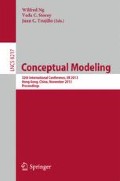Abstract
Models, according to common understanding, facilitate to make and share references. A reference is a deictic activity whose point of origin differs from its target. The activity of modeling rests on taking a reference’s point of origin as a substitute for its target. In this paper I discuss two aspects of modeling, namely abstraction and direction-of-fit. I am going to show that representation, rather than abstraction, is key to modeling and that the direction-of-fit is not inherent to a model.
Access this chapter
Tax calculation will be finalised at checkout
Purchases are for personal use only
Preview
Unable to display preview. Download preview PDF.
References
Booch, G., Rumbaugh, J., Jacobson, I.: The Unified Modeling Language user guide. Addison Wesley (1998)
Carnap, R.: Der logische Aufbau der Welt. Felix Meiner Verlag (1928)
Chen, P.: The Entity-Relationship model – toward a unified view of data. ACM ToDS 1(1) (1976)
Faroult, S., Robson, P.: The art of SQL. O’Reilly (2008)
Fleck, L.: Entstehung und Entwicklung einer wissenschaftlichen Tatsache. Einführung in die Lehre vom Denkstil und Denkkollektiv. Schwabe und Co., Verlagsbuchhandlung, Basel (1935)
Frigg, R., Hartmann, S.: Models in science. In: Zalta, E. (ed.) The Stanford Encyclopedia of Philosophy (fall 2012), http://plato.stanford.edu
Harel, D.: On visual formalisms. Communications of the ACM 31(5) (1988)
Harel, D., Rumpe, B.: Meaningful modeling: what’s the semantics of “semantics”? IEEE Computer 37(10) (2004)
Kamlah, W., Lorenzen, P.: Logische Propädeutik: eine Vorschule des vernünftigen Redens, 2nd edn. Bibliographisches Institut. (1973)
Kaschek, R.: A little theory of abstraction. In: Proceedings of Modellierung 2004, GI Edition. Lecture Notes in Informatics, p. 45. Bonn (2004)
Kaschek, R.: Modeling ontology use for information systems. In: Althoff, K.-D., Dengel, A.R., Bergmann, R., Nick, M., Roth-Berghofer, T.R. (eds.) WM 2005. LNCS (LNAI), vol. 3782, pp. 609–622. Springer, Heidelberg (2005)
Kralemann, B., Lattmann, C.: Models as icons: modeling models in the semiotic framework of Peirce’s theory of signs. Synthese (September 2012), doi:10.1007/s11229-012-0176-x
Lockemann, P., Mayr, H.: Rechnergestützte Informations systeme. Springer (1978)
Marx, K.: Theses on Feuerbach, vol. 1845 (2012), http://www.marxists.org/archive/marx/newlineworks/1845/theses/theses.htm (accessed on December 3)
Morris, C.: Signs, language and behavior. Prentice-Hall, Inc. (1946)
Muller, P.-A., Fondement, F., Baudry, B., Combemale, B.: Modeling modeling. Softw. Syst. Model 11 (2012)
Ramakrishnan, R., Gehrke, J.: Database management systems, 3rd edn. McGraw-Hil (2003)
Seidewitz, E.: What models mean. IEEE Software 20(5) (2003)
Stachowiak, H.: Allgemeine Modelltheorie. Springer (1973)
Teorey, T., Lightstone, S., Nadeau., T., Jagadish, H.V.: Database modeling and design: logical design, 5th edn. Morgan Kaufmann (2011)
Thalheim, B.: Syntax, semantics and pragmatics of conceptual modeling. In: Bouma, G., Ittoo, A., Métais, E., Wortmann, H. (eds.) NLDB 2012. LNCS, vol. 7337, pp. 1–10. Springer, Heidelberg (2012)
Thalheim, B.: The definition of the (conceptual) model. In: Proceedings of EJC 2013. IOS Press, Amsterdam (2013)
Wand, Y., Weber, R.: Research commentary: information systems and conceptual modeling – a research agenda. Information Systems Research 13(4) (2002)
Wieringa, R.: Algebraic foundations for dynamic conceptual models. PhD thesis, Free University of Amsterdam, Amsterdam (May 1990)
Author information
Authors and Affiliations
Editor information
Editors and Affiliations
Rights and permissions
Copyright information
© 2013 Springer-Verlag Berlin Heidelberg
About this paper
Cite this paper
Kaschek, R. (2013). A Semantic Analysis of Shared References. In: Ng, W., Storey, V.C., Trujillo, J.C. (eds) Conceptual Modeling. ER 2013. Lecture Notes in Computer Science, vol 8217. Springer, Berlin, Heidelberg. https://doi.org/10.1007/978-3-642-41924-9_8
Download citation
DOI: https://doi.org/10.1007/978-3-642-41924-9_8
Publisher Name: Springer, Berlin, Heidelberg
Print ISBN: 978-3-642-41923-2
Online ISBN: 978-3-642-41924-9
eBook Packages: Computer ScienceComputer Science (R0)

